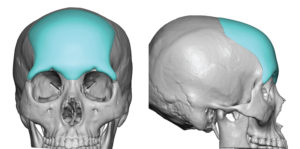The shape of the forehead is very gender specific. Besides the presence of prominent brow bones in males) and a flatter brow area in females, the shape of the forehead above it is also different. A male forehead is associated with a more recessed upper forehead back into then hairline while the feminine forehead has an overall more convex shape in profile that has a more vertical orientation. If the female forehead is flatter or more retroclined backward, it causes a pseudo brow bone appearance and a potentially less feminine appearance.

In the November 2019 issue of Plastic and Reconstructive Surgery an article on this topic was published entitled ‘Forehead Fat Grafting: Asian Facial Contouring and Augmentation.’ In this paper the authors evaluated 24 patients over a 6 year period who had fat grafting for forehead augmentation with the intent of evaluating its efficacy and effect on facial proportions. Their technique consisted of abdominal or thigh donor sites with syringe aspiration. Concentration of the fat was done using gravitational separation and gauze sponge purification. Injection was done with 1cc syringes with a hairline triangulation technique to access the central and lateral forehead subcutaneous areas. Aliquot placement was done using a 1.2mm injection cannula.
The average injected fat volume was 17ccs during a primary injection procedure. Nearly 1/3 of the patients (29%) had a secondary fat grafting procedure three months or later after the first procedure consisting of an average of 7cc of injected fat. No complications occurred in any of the patients including infection, vascular occlusions/emboli, skin necrosis, or oil cysts/fat necrosis. With an average followup of 8 months, more than 50% of the patients reported satisfactory results. The average forehead projection achieved some modest improvement at 0.24 U. (ration of horizontal distance of midforehead plane to corneal plane) The medial forehead height did not change postoperatively.
This paper demonstrates that injectable fat grafting has a valuable role to play in Asian forehead augmentation. Its advantages is that it is the patient’s tissue being injected and the procedure is relatively minimally invasive with limited recovery. But like all injection fat grafting procedures the volume retention is unpredictable and the patient must have a preoperative understanding that secondary fat grafting procedures may be needed. Also, and not mentioned in the article, is that it is also important for the patient to know that the procedure is very difficult if not impossible to reverse. Overcorrections and irregular contour issues can become problematic….although not seen in this patients series due to the judicious injection of fat volumes.

Dr. Barry Eppley
Indianapolis, Indiana


